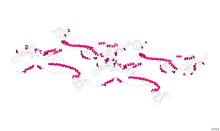Herpesvirus glycoprotein B
| Herpesvirus Glycoprotein B (PH-like 2) | |||||||||
|---|---|---|---|---|---|---|---|---|---|
 Crystallographic structure of glycoprotein B from herpes simplex virus type 1.[1] | |||||||||
| Identifiers | |||||||||
| Symbol | Glycoprot_B_PH2 | ||||||||
| Pfam | PF17417 | ||||||||
| InterPro | IPR038631 | ||||||||
| OPM superfamily | 109 | ||||||||
| OPM protein | 3nw8 | ||||||||
| |||||||||
| Herpesvirus Glycoprotein B (PH-like 1) | |||||||||
|---|---|---|---|---|---|---|---|---|---|
| Identifiers | |||||||||
| Symbol | Glycoprot_B_PH1 | ||||||||
| Pfam | PF17416 | ||||||||
| InterPro | IPR035377 | ||||||||
| |||||||||
| Herpesvirus glycoprotein B ectodomain | |||||||||
|---|---|---|---|---|---|---|---|---|---|
| Identifiers | |||||||||
| Symbol | Glycoprotein_B | ||||||||
| Pfam | PF00606 | ||||||||
| |||||||||
Herpesvirus glycoprotein B is a
cellular membrane or via endocytosis. Other viral glycoproteins involved in the process of viral cell entry include gC, gB, gD, gH, and gL, but only gC, gB, gD, and gH are required for the fusion of the HSV's envelope with the cellular membrane. It can be noted that all herpesviruses have glycoproteins gB, gH, and gL.[2]
Structure
The herpesvirus glycoprotein B is a
monoclonal antibodies map to structural domains I, II, IV and V.[7] Due to its unique structure, herpesvirus glycoprotein B (along with vesicular stomatitis virus glycoprotein G and baculovirus gp64) belongs to a new class of viral membrane fusion glycoproteins, class III.[3]
Function
The herpesvirus glycoprotein B is the most highly conserved of all surface glycoproteins and acts primarily as a fusion protein. The precise functions of gB and gH/gL are unknown but they are required for viral entry into the cell and constitute the core fusion machinery. The claim that gB is involved in fusion comes from the notable syncytial phenotype caused by certain mutations within the cytoplasmic domain of glycoprotein B,[8] as well as its structural homology to other viral fusion proteins.[3]
References
Further reading
- "Santa Cruz HSV Glycoprotein Datasheet" (PDF). Santa Cruz Biotechnology, Inc.
